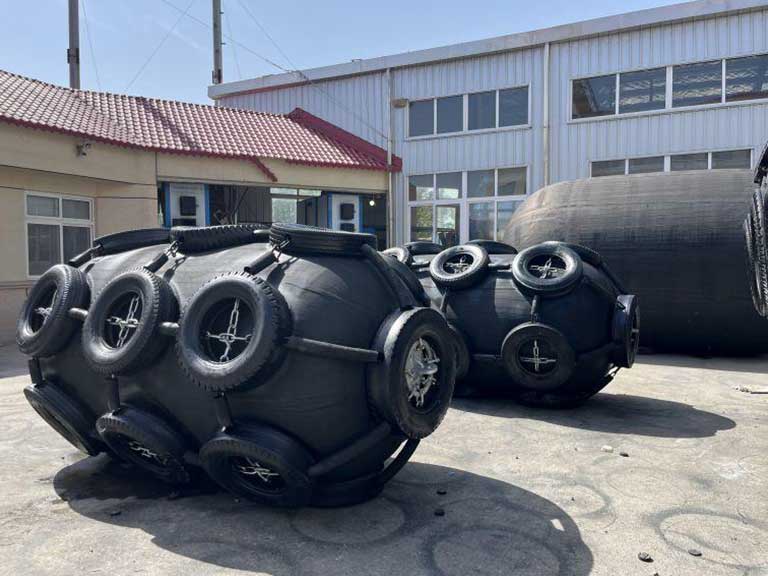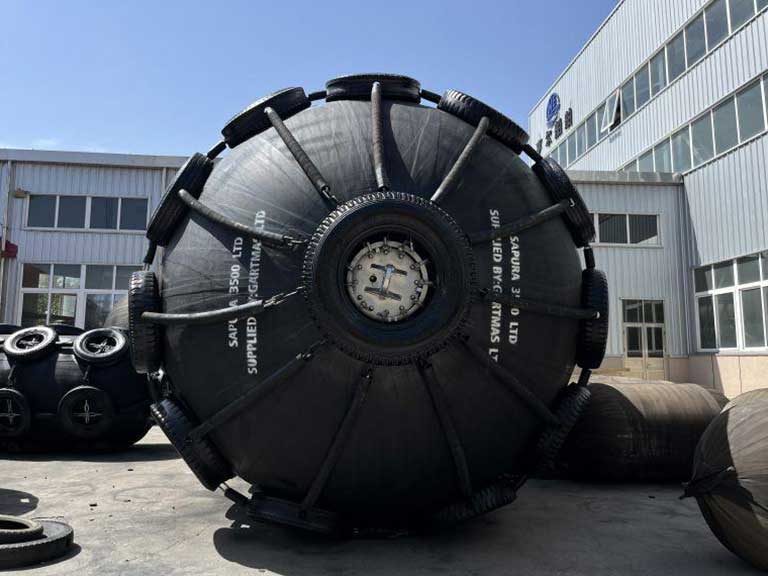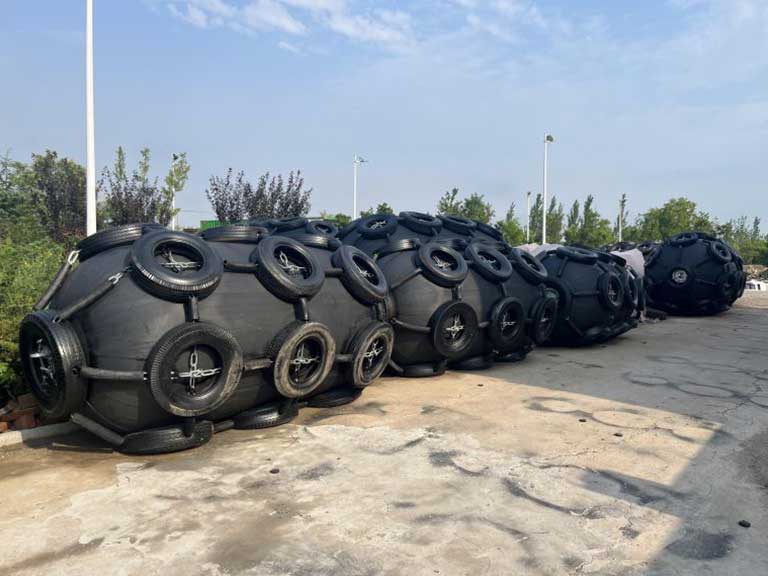Are you protecting your vessel from damage when docking or mooring? We know how crucial fenders are. They protect your boat from costly damage, especially in tough waters or crowded docks. Then, when should I install fenders on my boat?
Using the right fenders can make your boat last longer and look better. At Henger Shipping Supplies, we make top-notch marine products. This includes pneumatic fenders and marine rubber fenders for your boat’s safety.
In this guide, we’ll show you when to use fenders to avoid boat damage. Knowing when and how to use them makes boating safer and more secure.
Table of Contents
Understanding Boat Fenders and Their Importance
Boat fenders are key to protecting your vessel. Keeping your boat in good shape is important. Using fenders is a big part of that.
What Are Boat Fenders?
Boat fenders are special devices that cushion impacts. They protect your boat from docks, other boats, or structures. They come in various shapes, sizes, and materials for different boats.
- They absorb impact, reducing damage to your boat.
- Fenders are made for specific uses and materials.
Why Fenders Are Essential for Boat Protection
Fenders are very important. They save you money by preventing expensive repairs. They also keep passengers safe and help your boat’s value.
- Protect your boat’s hull from damage.
- They make boating safer for everyone on board.
- They help keep your boat’s value up.
The Cost of Not Using Proper Fenders
Without proper fenders, even small impacts can cause damage. Stronger impacts can harm your boat’s structure. Repeated small impacts can wear down your boat’s hull over time. Repair costs can be high, making fenders a smart choice.

Types of Marine Fenders for Different Boats
Marine fenders vary in shape, size, and material for different boats. This variety means you can find the right protection for your boat, no matter its size or docking needs.
Cylindrical Fenders
Cylindrical fenders are common and versatile. They fit many boats and docking situations. Their shape helps them absorb impact well, making them good for various boat sizes.
Ball Fenders
Ball fenders offer great protection at specific points. They’re good for boats with curved hulls or in tight spaces. Their shape spreads out impact, protecting both your boat and the dock.
Yokohama Fenders
Yokohama fenders are our specialty at Henger Shipping Supplies. They’re heavy-duty pneumatic fenders for big vessels and commercial use. They’re built to handle tough marine environments and keep your valuable assets safe.
Specialized Fenders for Different Vessel Types
Different boats need special fenders. From small boats to big ships, the right fender is key. Corner fenders fit pontoon boats, transom fenders protect the back, and bow fenders guard the front.
Choosing fenders depends on your boat’s size and where you dock. Also, think about the weather in your area. Our team makes custom fenders for any boat, ensuring they’re well-protected.
- Cylindrical rubber fenders protect many types of boats.
- Ball fenders are great for boats with curved hulls or tight spaces.
- Yokohama fenders are top-notch for big commercial ships.
- Specialized fenders meet specific needs for different boats.

Key Scenarios When You Should Put Fenders on Your Boat
Fenders are essential when docking or mooring. They act as a cushion, preventing damage from bumps. We’ll look at when fenders are a must for your boat’s safety.
Docking at Marinas and Piers
Docking at marinas and piers is common. Without fenders, your boat’s hull can get damaged. Fenders at key points prevent costly repairs and keep your boat in top shape.
Mooring Alongside Other Vessels
Mooring next to other boats is risky. Fenders on both boats prevent damage from waves and wind. Proper fender placement is crucial in crowded areas to avoid collisions.
Navigating Locks and Narrow Passages
Locks and narrow passages are challenging. Your boat may hit walls on both sides. Strategic fender placement is vital to avoid damage. With the right fenders, navigating these areas is safer.
During Rough Weather Conditions
Rough weather makes fenders even more important. Waves and wind can cause more damage. Fenders help protect your boat during bad weather.
Other situations like temporary stops, anchoring in crowded areas, and loading/unloading also need careful fender placement. Knowing when and how to use fenders reduces damage risks, keeping your boat safe.
Preparing Your Fenders Before Docking
Preparation is key for a smooth docking experience. Properly prepared fenders protect your boat and make docking easier. We help you get ready with the right equipment and knowledge.
Creating Proper “Fender Whips”
Creating “fender whips” needs attention. For fenders with molded eyes, use two lines, each as long as the fender. For cylindrical holes, use one line three times the fender’s length.
Secure the line with a figure-eight knot near the fender. This keeps the fender in place. Use soft nylon or spun Dacron line for strength and grip.

Selecting the Right Line for Fender Attachment
Choosing the right line for fender attachment is key for safety. Soft nylon or spun Dacron lines work well because they are strong and grip well. Avoid slippery lines, as they can cause knots to come undone easily. The type of line you use greatly affects your fender setup’s success.
Pre-Docking Fender Preparation Checklist
Before docking, check your fenders for damage and the line’s condition. Plan where to place your fenders based on your docking scenario. Proper preparation makes docking less stressful and keeps your boat safe.
With good preparation, docking becomes easier. You’ll know your fenders are ready to protect your boat.
How to Properly Put Fenders on Your Boat
Putting fenders on your boat is important to avoid damage. The way you place fenders depends on the docking surface and your boat’s design. We’ll show you how to use fenders to protect your boat effectively.
Determining Vertical vs. Horizontal Placement
Whether to use vertical or horizontal fenders depends on the docking surface. For docking alongside another boat or a flat dock, use vertical fenders. For pilings or posts, go horizontal. This protects your boat from damage.
Positioning Fenders at the Widest Part of the Boat
Place a large fender at your boat’s widest point. This area is most likely to hit the dock or other boats. Add fenders forward and aft for full protection, especially in windy or current conditions.
Using Fender Boards for Special Situations
For docking against wide pilings, use a fender board. It’s a flat piece of wood or composite material between two fenders. This keeps your boat’s topsides from rubbing against the dock.
Adjusting Fender Height for Different Docks
Adjusting fender height is crucial for protection. The right height depends on the dock’s height and your boat’s freeboard. For high topsides, attach fenders to midships cleats or the toerail. This reduces damage to your stanchions.
By following these tips, your boat will be well-protected during docking. Proper fender placement means peace of mind and avoids costly damage.

Mastering Fender Attachment Techniques
Fender attachment is a key skill for boat owners. It affects your boat’s safety and integrity during docking. Secure fenders properly to prevent damage and ensure a safe docking experience.
Tying a Proper Clove Hitch for Fenders
The clove hitch is the best knot for securing fenders. It keeps the fender in place even under pressure. To tie a clove hitch, pass the line over the rail, then around and over itself diagonally. Bring it over the rail again, then fish the working end underneath the diagonal. Pull it tight. The knot should have two parallel lines in opposite directions. Finish with a half-hitch or overhand knot to prevent slippage.
Using Slippery Hitches for Quick Adjustments
The clove hitch is great for security, but it’s hard to adjust fast. To fix this, add a slippery hitch to the clove hitch. This makes it easy to change the height or release the line quickly. Just pass the bitter end through the hitch again to secure it with a slippery hitch.
Alternative Attachment Methods
There are other ways to attach fenders too. You can use special fender hangers, quick-release clips, or adjustable mounts. Each has its own benefits for different boating needs, making things easier and more convenient.
Common Fender Attachment Mistakes to Avoid
When you attach fenders, don’t make common mistakes. Avoid putting fenders too high, using thin lines, or not finishing the knot. Knowing these mistakes can help you dock safely and securely.
| Attachment Method | Advantages | Best Use Scenario |
| Clove Hitch | Reliable, maintains position under pressure | General docking situations |
| Slippery Hitch Modification | Allows for quick adjustments | Docking in varying conditions or tight spaces |
| Specialized Fender Hangers | Easy to use, secure attachment | Boats with specific fender attachment needs |
Learning these fender attachment methods helps keep your boat safe when docking. It doesn’t matter what the conditions are.

Fender Positioning for Different Docking Scenarios
Different docking situations need careful fender placement for your boat’s safety. Proper fender positioning helps avoid damage to your boat and the dock or other boats. We’ll show you the best ways to place fenders in different docking situations.
Alongside Flat Docks and Seawalls
For docking next to flat docks and seawalls, place your fenders vertically. Do this at regular intervals along your boat’s hull. This covers all possible contact points, protecting your boat from the dock’s flat surface.
Against Pilings and Posts
When docking against pilings and posts, use horizontal fenders. Place them at the height where the pilings will hit your boat. This setup helps absorb the impact and keeps your boat’s hull safe.
In Tight Slips and Marinas
In tight slips and crowded marinas, place fenders on both sides of your boat. Unexpected hits can come from any direction. So, it’s key to have fenders ready to protect your boat from any impact.
When Rafting with Other Boats
When rafting with other boats, work with the other boat’s owner on fender placement. This way, you both get the best protection and avoid gaps in coverage. This keeps both boats safe from damage.
Repositioning Fenders After Securing Your Boat
After securing your boat, adjust your fenders for better protection. Don’t leave fenders on the top rail or lifeline, as this can cause too much pressure. For boats with high topsides, attach fenders to midships cleats, toerails, or the bottom of stanchions. This reduces leverage and prevents damage.
| Docking Scenario | Fender Placement | Benefits |
| Alongside Flat Docks and Seawalls | Vertical placement at regular intervals | Complete coverage of potential contact points |
| Against Pilings and Posts | Horizontal placement at the height of contact | Absorbs impact and prevents hull damage |
| In Tight Slips and Marinas | Strategic placement on both sides of the vessel | Protection from multiple directions |
| Rafting with Other Boats | Coordinated placement with other vessel owners | Complementary protection and prevention of gaps in coverage |

Selecting Quality Marine Fenders for Long-Term Protection
The quality of your marine fenders is crucial for your boat’s safety. Quality fenders are more than just accessories; they’re a vital investment in your boat’s long-term protection.
Important Quality Certifications to Look For
When choosing marine fenders, look for quality certifications. At Henger Shipping Supplies, our products are ISO9001-2008 certified by maritime authorities like CCS, BV, GL, ABS, LG, and IACS. These certifications mean our fenders meet international standards and quality control.
Materials That Provide the Best Protection
The material of fenders greatly affects their protection. Marine-grade PVC, reinforced rubber, and special polymers offer different levels of durability and shock absorption. Premium fenders also have UV-resistant materials to prevent sun damage.
Investing in Durable Marine Equipment
Buying durable marine gear means your equipment lasts longer and works better. Look for fenders with strong attachment points and even thickness. Also, make sure pneumatic models have good pressure systems. Choose fenders based on your boating area’s weather.
| Fender Material | Durability | UV Resistance |
| Marine-grade PVC | High | Excellent |
| Reinforced Rubber | Very High | Good |
| Specialized Polymers | High | Excellent |
Conclusion
Our guide on boat fenders shows how important they are for your boat’s safety. We talked about when to use fenders, from docking to special situations.
Using the fenders correctly is key to keeping your boat safe and looking good. At Henger Shipping Supplies, we know how important good fenders are for your boat’s safety.
To get the most from your fenders, learn how to attach them well. Use the right knots and place them correctly. A pre-docking routine helps you stay ready. Check your fenders often for damage and replace them when needed.
By following these tips and choosing quality fenders, you’ll keep your boat safe. Enjoy boating more with confidence.

FAQ
What is the primary function of boat fenders?
Boat fenders protect your boat from damage when docking. They absorb impacts and keep your boat’s hull safe.
What are the different types of marine fenders available?
There are many marine fenders, such as cylindrical and ball fenders. There are also special fenders for certain boats or docking needs.
How do I properly attach fenders to my boat?
Attach fenders with a secure knot, like a clove hitch. Make sure they’re in the right spot. Fender boards can add extra protection in some cases.
What are some common mistakes to avoid when using fenders?
Avoid wrong fender placement and size. Also, adjust the fender height for different docking conditions.
Can I use fenders in rough weather conditions?
Yes, fenders work in rough weather to protect your boat. Just make sure they’re secure to avoid damage.
How do I maintain and inspect my marine fenders?
Check your fenders for wear and damage often. Clean and store them properly when not in use.

